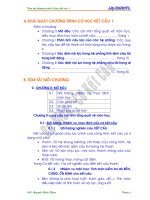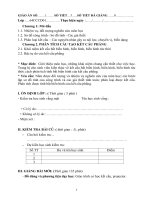cơ học kết cấu tiếng anh
Bạn đang xem bản rút gọn của tài liệu. Xem và tải ngay bản đầy đủ của tài liệu tại đây (16.81 MB, 899 trang )
Temperature Conversion Formulas T(°C) ϭ
ᎏ
5
9
ᎏ
[T(°F) Ϫ 32] ϭ T(K) Ϫ 273.15
T(K) ϭ
ᎏ
5
9
ᎏ
[T(°F) Ϫ 32] ϩ 273.15 ϭ T(°C) ϩ 273.15
T(°F) ϭ
ᎏ
9
5
ᎏ
T(°C) ϩ 32 ϭ
ᎏ
9
5
ᎏ
T(K) Ϫ 459.67
CONVERSIONS BETWEEN U.S. CUSTOMARY UNITS AND SI UNITS (Continued)
Times conversion factor
U.S. Customary unit
Accurate Practical
Equals SI unit
Moment of inertia (area)
inch to fourth power in.
4
416,231 416,000 millimeter to fourth
power mm
4
inch to fourth power in.
4
0.416231 ϫ 10
Ϫ6
0.416 ϫ 10
Ϫ6
meter to fourth power m
4
Moment of inertia (mass)
slug foot squared slug-ft
2
1.35582 1.36 kilogram meter squared kg·m
2
Power
foot-pound per second ft-lb/s 1.35582 1.36 watt (J/s or N·m/s) W
foot-pound per minute ft-lb/min 0.0225970 0.0226 watt W
horsepower (550 ft-lb/s) hp 745.701 746 watt W
Pressure; stress
pound per square foot psf 47.8803 47.9 pascal (N/m
2
)Pa
pound per square inch psi 6894.76 6890 pascal Pa
kip per square foot ksf 47.8803 47.9 kilopascal kPa
kip per square inch ksi 6.89476 6.89 megapascal MPa
Section modulus
inch to third power in.
3
16,387.1 16,400 millimeter to third power mm
3
inch to third power in.
3
16.3871 ϫ 10
Ϫ6
16.4 ϫ 10
Ϫ6
meter to third power m
3
Velocity (linear)
foot per second ft/s 0.3048* 0.305 meter per second m/s
inch per second in./s 0.0254* 0.0254 meter per second m/s
mile per hour mph 0.44704* 0.447 meter per second m/s
mile per hour mph 1.609344* 1.61 kilometer per hour km/h
Volume
cubic foot ft
3
0.0283168 0.0283 cubic meter m
3
cubic inch in.
3
16.3871 ϫ 10
Ϫ6
16.4 ϫ 10
Ϫ6
cubic meter m
3
cubic inch in.
3
16.3871 16.4 cubic centimeter (cc) cm
3
gallon (231 in.
3
) gal. 3.78541 3.79 liter L
gallon (231 in.
3
) gal. 0.00378541 0.00379 cubic meter m
3
*An asterisk denotes an exact conversion factor
Note: To convert from SI units to USCS units, divide by the conversion factor
This page intentionally left blank
Structural Analysis
Fourth Edition, SI
Aslam Kassimali
Southern Illinois University—Carbondale
SI Edition prepared by Amit Prashant,
Indian Institute of Technology, Kanpur
Australia
Brazil
Japan
Korea
Mexico
Singapore
Spain
United Kingdom
United States
Structural Analysis, Fourth Edition, SI
Aslam Kassimali
SI Edition prepared by Amit Prashant
Publisher: Christopher M. Shortt
Senior Developmental Editor: Hilda Gowans
Acquisitions Editor, SI Edition: Swati Meherishi
Editorial Assistant: Tanya Altieri
Team Assistant: Carly Rizzo
Marketing Manager: Lauren Betsos
Content Project Manager: Diane Bowdler
Production Service: RPK Editorial Services
Copyeditor: Harlan James
Proofreader: Erin Wagner
Indexer: Shelly Gerger-Knecthl
Compositor: Integra
Senior Art Director: Michelle Kunkler
Cover Designer: Andrew Adams
Cover Image: Mikael Damkier/Shutterstock
Text and Image Permissions Researcher:
Kristiina Paul
Permissions Account Manager, Text: Mardell
Glinski-Schultz
Permissions Account Manager, Images: John Hill
Senior First Print Buyer: Arethea L. Thomas
ª 2011 Cengage Learning
ALL RIGHTS RESERVED. No part of this work covered by the copyright herein may be
reproduced, transmitted, stored, or used in any form or by any means graphic, electro nic, or
mechanical, including but not limited to photocopying, recording, scanning, digitizing, taping,
web distribution, information networks, or information storage and retrieval systems, except
as permitted under Section 107 or 108 of the 1976 United States Copyright Act, without the
prior written permission of the publisher.
For product information and technology assistance, contact us at
Cengage Learning Customer & Sales Support,
1-800-354-9706.
For permission to use material from this text or product, submit
all requests online at www.cengage.com/permissions.
Further permissions questions can be emailed to
Library of Congress Control Number: 2009940222
ISBN-13: 978-0-495-29567-9
ISBN-10: 0-495-29567-1
Cengage Learning
200 First Stamford Place, Suite 400
Stamford, CT 06902
USA
Cengage Learning is a leading provider of customized learning
solutions with office locations around the globe, including Singapore,
the United Kingdom, Australia, Mexico, Brazil, and Japan. Locate your
local office at: international.cengage.com/region.
Cengage Learning products are represented in Canada by
Nelson Education Ltd.
For your course and learning solutions, visit
www.cengage.com/engineering.
Purchase any of our products at your local college store or at our
preferred online store www.ichapters.com.
Printed in the United States of America
12345671312111009
IN MEMORY OF AMI
This page intentionally left blank
Contents
Preface to the SI Edition xiii
Preface xiv
PART ONE INTRODUCTION TO STRUCTURAL ANALYSIS AND LOADS 1
1 Introduction to Structural Analysis 3
1.1 Historical Background 4
1.2 Role of Structural Analysis in Structural Engineering Projects 6
1.3 Classification of Structures 7
1.4 Analytical Models 12
Summary 16
2 Loads on Structures 17
2.1 Dead Loads 18
2.2 Live Loads 21
2.3 Impact 24
2.4 Wind Loads 24
2.5 Snow Loads 32
2.6 Earthquake Loads 35
2.7 Hydrostatic and Soil Pressures 37
2.8 Thermal and Other E¤ects 37
2.9 Load Combinations 37
Summary 38
Problems 39
vii
PART TWO ANALYSIS OF STATICALLY DETERMINATE STRUCTURES 41
3 Equilibrium and Support Reactions 43
3.1 Equilibrium of Structures 43
3.2 External and Intern al Forces 46
3.3 Types of Supports for Plane Structures 47
3.4 Static Determinacy, Indeterminacy, and Instability 47
3.5 Computation of Reactions 60
3.6 Principle of Superposition 78
3.7 Reactions of Simply Supported Structures Using Proportions 79
Summary 80
Problems 82
4 Plane and Space Trusses 89
4.1 Assumptions for Analysis of Trusses 91
4.2 Arrangement of Members of Plane Trusses—Internal
Stability 95
4.3 Equations of Condition for Plane Trusse s 100
4.4 Static Determinacy, Indeterminacy, and Instability of Plane
Trusses 100
4.5 Analysis of Plane Trusses by the Method of Joints 106
4.6 Analysis of Plane Trusses by the Method of Sections 121
4.7 Analysis of Compound Trusses 128
4.8 Complex Trusses 133
4.9 Space Trusses 134
Summary 144
Problems 145
5 Beams and Frames: Shear and Bending Moment 160
5.1 Axial Force, Shear, and Bending Moment 161
5.2 Shear and Bending Moment Diagrams 167
5.3 Qualitative Deflected Shapes 172
5.4 Relationships between Loads, Shears, and Bending Moments 173
5.5 Static Determinacy, Indeterminacy and Instability of Plane
Frames 195
viii Contents
5.6 Analysis of Plane Frames 201
Summary 215
Problems 217
6 Deflections of Beams: Geometric Methods 226
6.1 Di¤erential Equation for Beam Deflection 227
6.2 Direct Integration Method 230
6.3 Superposition Method 233
6.4 Moment-Area Method 234
6.5 Bending Moment Diagrams by Parts 248
6.6 Conjugate-Beam Method 253
Summary 269
Problems 269
7 Deflections of Trusses, Beams, and Frames: Work–Energy Methods 275
7.1 Work 276
7.2 Principle of Virtual Work 278
7.3 Deflections of Trusses by the Virtual Work Method 282
7.4 Deflections of Beams by the Virtual Work Method 293
7.5 Deflections of Frames by the Virtual Work Method 301
7.6 Conservation of Energy and Strain Energ y 312
7.7 Castigliano’s Second Theorem 316
7.8 Betti’s Law and Maxwell’s Law of Reciprocal Deflections 325
Summary 326
Problems 328
8 Influence Lines 337
8.1 Influence Lines for Beams and Frames by Equilibrium
Method 338
8.2 Mu
¨
ller-Breslau’s Principle and Qualitative Influence Lines 353
8.3 Influence Lines for Girders with Floor Systems 367
8.4 Influence Lines for Trusses 377
8.5 Influence Lines for Deflections 389
Summary 392
Problems 393
Contents ix
9 Application of Influence Lines 401
9.1 Response at a Particular Location Due to a Single Moving
Concentrated Load 401
9.2 Response at a Particular Location Due to a Uniformly
Distributed Live Load 403
9.3 Response at a Particular Location Due to a Series of Moving
Concentrated Loads 408
9.4 Absolute Maximum Response 415
Summary 421
Problems 422
10 Analysis of Symmetric Structures 425
10.1 Symmetric Structures 426
10.2 Symmetric and Antisymmetric Components of Loadings 432
10.3 Behavior of Symmetric Structures under Symmetric and
Antisymmetric Loadings 443
10.4 Procedure for Analysis of Symmetric Structures 447
Summary 455
Problems 456
PART THREE ANALYSIS OF STATICALLY INDETERMINATE STRUCTURES 459
11 Introduction to Statically Indeterminate Structures 461
11.1 Advantages and Disadvantages of Indeterminate Structures 462
11.2 Analysis of Indeterminate Structures 465
Summary 470
12 Approximate Analysis of Rectangular Building Frames 471
12.1 Assumptions for Approximate Analysis 472
12.2 Analysis for Vertical Loads 475
12.3 Analysis for Lateral Loads—Portal Method 481
12.4 Analysis for Lateral Loads—Cantilever Method 497
Summary 504
Problems 505
x Contents
13 Method of Consistent Deformations —Force Method 508
13.1 Structures with Single Degree of Indeterminacy 509
13.2 Internal Forces and Moments as Redundants 531
13.3 Structures with Multiple Degrees of Indeterminacy 544
13.4 Support Settlements, Temperature Changes and Fabrication
Errors 568
Summary 577
Problems 578
14 Three-Moment Equation and the Method of Least Work 586
14.1 Derivation of Three-Moment Equation 587
14.2 Application of Three-Moment Equation 592
14.3 Method of Least Work 599
Summary 606
Problems 607
15 Influence Lines for Statically Indeterminate Structures 609
15.1 Influence Lines for Beams and Trusses 610
15.2 Qualitative Influence Lines by Mu
¨
ller-Breslau’s Principle 627
Summary 631
Problems 632
16 Slope-Deflection Method 635
16.1 Slope-Deflection Equations 636
16.2 Basic Concept of the Slope-Deflection Method 644
16.3 Analysis of Continuous Beams 651
16.4 Analysis of Frames without Sidesway 673
16.5 Analysis of Frames with Sidesway 681
Summary 702
Problems 702
17 Moment-Distribution Method 707
17.1 Definitions and Terminology 708
17.2 Basic Concept of the Moment-Distribution Method 717
17.3 Analysis of Continuous Beams 725
Contents xi
17.4 Analysis of Frames without Sidesway 741
17.5 Analysis of Frames with Sidesway 744
Summary 761
Problems 762
18 Introduction to Matrix Structural Analysis 767
18.1 Analytical Model 768
18.2 Member Sti¤ness Relations in Local Coordinates 772
18.3 Coordinate Transformations 780
18.4 Member Sti¤ness Relations in Global Coordinates 786
18.5 Structure Sti¤ness Relations 787
18.6 Procedure for Analysis 795
Summary 813
Problems 814
Appendix A Areas and Centroids of Geometric Shapes 817
Appendix B Review of Matrix Algebra 82 1
B.1 Definition of a Matrix 821
B.2 Types of Matrices 822
B.3 Matrix Operations 824
B.4 Solution of Simultaneous Equations by the Gauss-Jordan
Method 831
Problems 835
Appendix C Computer Software 837
Starting the Compu ter Software 837
Inputting Data 837
Results of the Analysis 844
Problems 849
Bibliography 851
Answers to Selected Problems 853
Index 863
xii Contents
Preface to the SI Edition
xiii
This edition of Structural Analysis has been adapted to incorporate the Interna-
tional System of Units (Le Syste
`
me International d’Unite
´
s or SI) throughout the
book. Amit Prashant wishes to acknowledge the contributions made by his col-
leagues, Arindam Dey, and Kaustubh Dasgupta to this SI Edition.
Le Syste
`
me International d’Unite
´
s
The United States Customary System (USCS) of units uses FPS (foot-pound-
second) units (also called English or Imperial units). SI units are primarily the
units of the MKS (meter-kilogram-second) system. However, CGS (centimeter-
gram-second) units are often accepted as SI units, especially in textbooks.
Using SI Units in this Book
In this book, we have used both MKS and CGS units. USCS units or FPS units
used in the US Edition of the book have been converted to SI units throughout
the text and problems. However, in case of data sourced from handbooks, gov-
ernment standards, and product manuals, it is not only extremely di‰cult to
convert all values to SI, it also encroaches upon the intellectual property of the
source. Also, some quantities such as the ASTM grain size number and Jominy
distances are generally computed in FPS units and would lose their relevance if
converted to SI. Some data in figures, tables, examples, and references, there-
fore, remains in FPS units. For readers unfamiliar with the relationship between
the FPS and the SI systems, conversion tables have been provided inside the
front and back covers of the book.
To solve problems that require the use of sourced data, the sourced values can
be converted from FPS units to SI units just before they are to be used in a calcu-
lation. To obtain standardized quantities and manufacturers’ data in SI units, the
readers may contact the appropriate government agencies or authorities i n their
countries/regions.
Instructor Resources
A Printed Instructor’s Solution Manual in SI units is available on request. An
electronic version of the Instructor’s Solutions Manual, and PowerPoint slides of
the figures from the SI text are available through www.cengage.com/engineering.
The readers’ feedback on this SI Edition will be highly appreciated and will
help us improve subsequent editions.
The Publishers
Preface
The objective of this book is to develop an understanding of the basic
principles of structural analysis. Emphasizing the intuitive classical ap-
proach, Structural Analysis covers the analysis of statically determinate
and indeterminate beams, trusses, and rigid frames. It also presents an
introduction to the matrix analysis of structures.
The book is divided into three parts. Part One presents a general
introduction to the subject of structural engineering. It includes a chap-
ter devoted entirely to the topic of loads because attention to this im-
portant topic is generally lacking in many civil engineering curricula.
Part Two, consi sting of Chapters 3 through 10, covers the analysis of
statically determinate beams, trusses, and rigid frames. The chapters on
deflections (Chapters 6 and 7) are placed before those on influence lines
(Chapters 8 and 9), so that influence lines for deflections can be included
in the latter chapters. This part also contains a chapter on the analysis
of symmetric structures (Chapter 10). Part Three of the book, Chapters
11 through 18, covers the analysis of statically indeterminate structures.
The format of the book is flexible to enable instructors to emph asize
topics that are consistent with the goals of the course.
Each chapter of the book begins with an introductory section de-
fining its objective and ends with a summary section outlining its salient
features. An important general feature of the book is the inclusion of
step-by-step procedures for analysis to enable students to make an easier
transition from theory to proble m solving. Numerous solved examples
are provided to illustrate the application of the fundamental concepts.
A computer program for analyzing plane framed structures is
available on the publisher’s website www.cengage.com/engineering.
This interactive software can be used to simulate a variety of structural
and loading configurations and to determine cau se versus e¤ect rela-
tionships between loading and various structural parameters, thereby
enhancing the students’ understanding of the behavior of structures.
The software shows deflected shapes of structures to enhance students’
xiv
understanding of structural response due to various types of loadings. It
can also include the e¤ects of support settlements, temperature changes,
and fabrication errors in the analysis. A solutions manual, containing
complete solutions to over 600 text exercises, is also available for the
instructor.
A NOTE ON THE REVISED EDITION
In this fourth edition, while the major features of the third editon have
been retained, over 15 percent of the problems from the previous edition
have been replaced with new ones. The chapter on loads has been revised
to meet the provisions of the ASCE 7-05 Standard, and the treatment of
the structures with internal hinges has been expanded in Chapter 3. The
computer software has been upgraded to make it compatible with the
latest versions of Microsoft Windows. Finally, most of the photographs
have been replaced with new ones, and the page layout of the book has
been redesigned to enhance clarity.
ACKNOWLEDGMENTS
I wish to express my thanks to Christopher Carson and Hilda Gowans
of Cengage Learning for their constant support and encourag ement
throughout this project, and to Rose Kernan for all her help during the
production phase. The comments and suggestions for improvement
from colleagues and students who have used previous editions are
gratefully acknowledged. All of their suggestions were carefully consid-
ered, and implemented whenever possible. Thanks are due to the
following reviewers for their careful reviews of the manuscripts of the
various editions, and for their constructive suggestions:
Ayo Abatan
Virginia Polytechnic Institute and
State University
Riyad S. Aboutaha
Georgia Institute of Technology
Osama Abudayyeh
Western Michigan University
Thomas T. Baber
University of Virginia
Gordon B. Batson
Clarkson University
George E. Blandford
University of Kentucky
Preface xv
Ramon F. Borges
Penn State/Altoona College
Kenneth E. Buttry
University of Wisconsin
Steve C. S. Cai
Louisiana State University
William F. Carroll
University of Central Florida
Malcolm A. Cutchins
Auburn University
Jack H. Emanuel
University of Missouri—Rolla
Fouad Fanous
Iowa State Universit y
Leon Feign
Fairfield University
Robert Fleischman
University of Notre Dame
George Kostyrko
California State University
E. W. Larson
California State University/
Northridge
Eugene B. Loverich
Northern Arizona University
L. D. Lutes
Texas A&M University
David Mazurek
US Coast Guard Academy
Ahmad Namini
University of Miami
Arturo E. Schultz
North Carolina State University
Kassim Tarhini
Valparaiso University
Robert Taylor
Northeastern University
C. C. Tung
North Carolina State University
Nicholas Willems
University of Kansas
John Zachar
Milwaukee School of Engineering
Mannocherh Zoghi
University of Dayton
Finally, I would like to express my loving appreciation to my wife.
Maureen, for her constant encouragement and help in preparing this
manuscript, and to my sons, Jamil and Nadim, for their enormous un-
derstanding and patience.
Aslam Kassimali
xvi Preface
Part One
Introduction to
Structural Analysis and Loads
This page intentionally left blank
1
Introduction to
Structural Analysis
1.1 Historical Background
1.2 Role of Structural Analysis in Structural Engineering Projects
1.3 Classification of Structures
1.4 Analytical Models
Summary
3
Structural analysis is the prediction of the performance of a given struc-
ture under prescribed loads and/or other external e¤ects, such as support
movements and temperature changes. The performance characteristics
commonly of interest in the design of structures are (1) stresses or stress
resultants, such as axial forces, shear forces, and bending moments; (2)
deflections; and (3) support reactions. Thus, the analysis of a structure
usually involves determination of these quantities as caused by a given
loading condition. The objective of this text is to present the methods
for the analysis of structures in static equilibrium.
This chapter provides a general introduction to the subject of struc-
tural analysis. We first give a brief historical background, including
names of people whose work is important in the field. Then we discuss
the role of structural analysi s in structural engineering projects. We de-
scribe the five common types of structures: tension and compression
structures, trusses, and shear and bending structures. Finally, we con-
sider the development of the simplified models of real structures for the
purpose of analysis.
Marina City District, Chicago
Hisham Ibrahim / Photographer’s Choice RF /Getty Images
1.1 HISTORICAL BACKGROUND
Since the dawn of history, structural engineering has been an essential
part of human endeavor. However, it was not until about the middle of
the seventeenth century that engineers began applying the knowledge
of mechanics (mathematics and science) in designing structures. Earlier
engineering structures were designed by trial and error and by using rules
of thumb based on past experience. The fact that some of the mag-
nificent structures from earlier eras, such as Egyptian pyramids (about
3000 b.c.), Greek temples (500–200 b.c.), Roman coliseums and aque-
ducts (200 b.c.–a.d. 200), and Gothic cathedrals (a.d. 1000–1500), still
stand today is a testimonial to the ingenuity of their builders (Fig. 1.1).
Galileo Galilei (1564–1642) is generally considered to be the origi-
nator of the theory of structures. In his book entitled Two New Sciences,
which was publish ed in 1638, Galileo analyzed the failure of some sim-
ple structures, including cantilever beams. Although Galileo’s predic-
tions of strengths of beams were only approximate, his work laid the
foundation for future developments in the theory of structures and
FIG. 1.1 The Cathedral of Notre Dame
in Paris Was Completed in the
Thirteenth Century
Ritu Manoj Jethani / Shutterstock
4 CHAPTER 1 Introduction to Structural Analysis
ushered in a new era of structural engineering, in which the analytical
principles of mechanics and strength of materials would have a major
influence on the design of structures.
Following Galileo’s pioneering work, the knowledge of structural
mechanics adv anced at a rapid pace in the second half of the seven-
teenth century and into the eighteenth century. Among the notable in-
vestigators of that period were Robert Hooke (1635–1703), who devel-
oped the law of linear relationships between the force and deformati on
of materials (Hooke’s law); Sir Isaac Newton (1642–1727), who formu-
lated the laws of motion and developed calculus; John Bernoulli (1667–
1748), who formulated the principle of virtual work; Leonhard Euler
(1707–1783), who developed the theory of buckling of columns; and C.
A. de Coulomb (1736–1806), who presented the analysis of bending of
elastic beams.
In 1826 L. M. Navier (1785–1 836) published a treatise on elastic
behavior of structures, which is considered to be the first textbook on
the modern theory of strength of materials. The development of struc-
tural mech anics continued at a tremendous pace throughout the rest of
the nineteenth century and into the first half of the twentieth, when most
of the classical methods for the analysis of structures described in this
text were developed. The important contributors of this period included
B. P. Clapeyron (1799–1864), who formulated the three-moment equa-
tion for the analysis of continuous beams; J. C. Maxwell (1831–1879),
who presented the method of consistent deformations and the law of
reciprocal deflections; Otto Mohr (1835–1918), who developed the con-
jugate-beam method for calculation of deflections and Mohr’s circles
of stress and strain; Alberto Castigliano (1847–1884), who formulated
the theorem of least work; C. E. Greene (1842–1903), who developed
the moment-area method; H. Mu
¨
ller-Breslau (1851–1925), who pre-
sented a principle for constructing influence lines; G. A. Maney (1888–
1947), who developed the slope-deflection method, which is considered
to be the precursor of the matrix sti¤ness method; and Hardy Cross
(1885–1959), who developed the moment-distribution method in 1924.
The moment-distribution method provided engineers with a simple iter-
ative procedure for analyzing highly statically indeterminate structures.
This method, which was the most widely used by structural engineers
during the period from about 1930 to 1970, contributed significantly to
their understanding of the behavior of statically indeterminate frames .
Many structures designed during that period, such as high-rise buildings,
would not have been possible without the availability of the moment-
distribution method.
The availability of computers in the 1950s revolutionized structural
analysis. Because the computer could solve large systems of simulta-
neous equations, analyses that took days and sometimes weeks in the
precomputer era could now be per formed in seconds. The development
of the current comput er-oriented methods of structural analysis can be
attributed to, among others, J. H. Argyris, R. W. Clough, S. Kelsey,
SECTION 1.1 Historical Background 5
R. K. Livesley, H. C. Martin, M. T. Turner, E. L. Wilson, and O. C.
Zienkiewicz.
1.2 ROLE OF STRUCTURAL ANALYSIS IN STRUCTURAL ENGINEERING PROJECTS
Structural engineering is the science and art of planning, designing, and
constructing safe and economical structures that will serve their intended
purposes. Structural ana lysis is an integral part of any structural engi-
neering project, its function being the prediction of the performance of
the proposed structure. A flowchart showing the various phases of a
typical structural engineering project is presented in Fig. 1.2. As this di-
agram indicates, the process is an iterative one, and it generally consi sts
of the following steps:
1. Planning Phase The planning phase usually involves the establish-
ment of the functional requirements of the proposed structure, the
FIG. 1.2 Phases of a Typical Structural
Engineering Project
6 CHAPTER 1 Introduction to Structural Analysis









